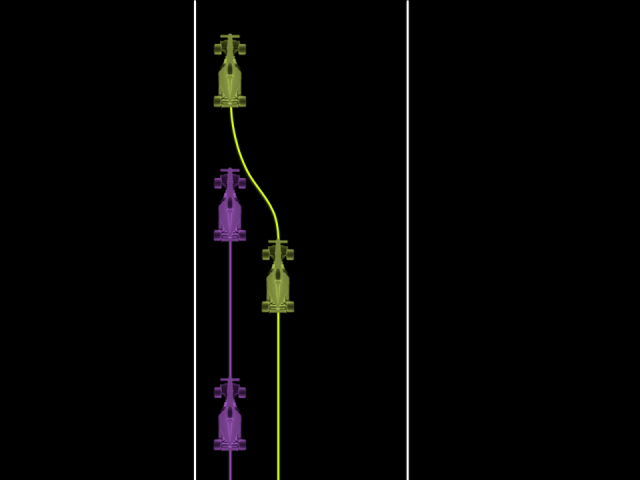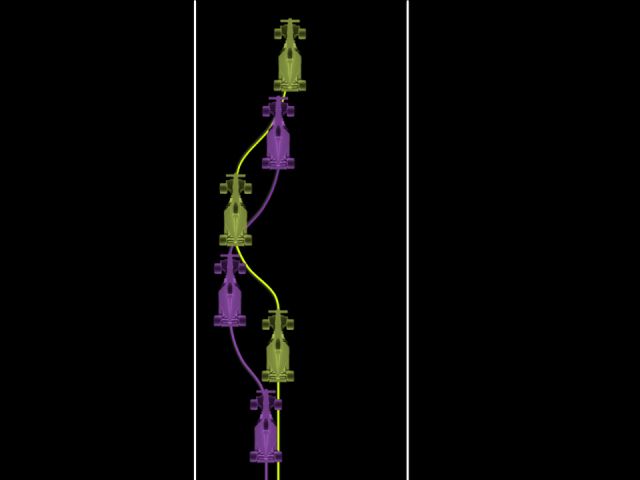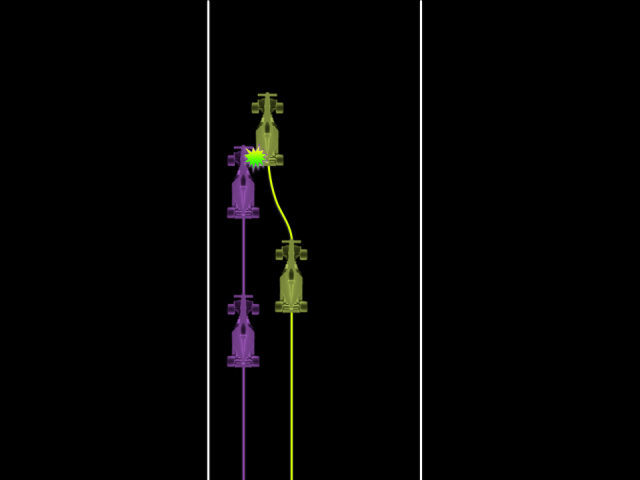Qualifying:
Race:
Races are not won on the first lap. There is a higher probability of ruining another driver’s race by taking unnecessary risks.
Passing:
The passing driver is responsible for making a safe pass at a safe time. It is the responsibility of both drivers to make sure that a safe pass is made. Failure to do so may result in a penalty.
Entering a turn, the passing driver must at least get their front wheels even with the rear wheels of the car they are passing before the point of turn-in, to have earned the right to a racing lane. At this point the driver being passed is responsible to leave a lane open.
Bump-passing is not allowed and may be subject to penalty unless the offending driver gives back the pass, even if it occurred accidentally. Bump-passing is defined as the passing driver nudging the car ahead to make it unstable, then passing it while the passed driver is recovering control.
Blocking is not allowed for any reason. Blocking is defined as altering the race line more than once in reaction to another driver in an attempt to prevent a pass. Blocking will be penalized.
Defending:
1.A The one-move rule

When one driver is completely ahead of another on a straight, they are allowed to make only one move in one direction. This move can be of any size, within the track limits, and the move can be made as slowly or as quickly as the driver likes.
More than one change of direction on a straight is called weaving and is NOT permitted.

1.B Racing alongside another car
If two cars have any parts alongside one another, each driver must respect the space occupied by the other car. It does not matter who is ahead, not how far they are ahead, they may not initiate a move into the other car. Both drivers have the right to continue driving in a straight line unimpeded.

1.C Entering the braking zone
On a straight, a defending driver has the right to suddenly change direction, even using the entire track width if they are fully ahead of the attacking driver. Sudden changes of direction just before or within the braking zone are not permitted
1.D Brake testing is not permitted
Brake-testing (i.e., braking hard earlier than normal to cause the driver behind to take evasive action or crash) is also highly dangerous and frowned upon, but not explicitly mentioned in the FIA sporting regulations.
Incidents:
Incident – contact with other driver or track boundaries.
Incident points are calculated depending on crash impact speed ranging 1-2-4 for single contact. Maximum incidents per race – 12.
Driver who collects 12 incidents in a race will be automatically banned from particular server.
Every session incidents counts individually.
Incidents after the finish doesn’t effect your result, but do effect driver incidents statistic.
Conscious contact:
Intentional conscious contact with another car will be penalized.
Recovery:
If a driver spins while on track, they should immediately lock their brakes until completely stopped, (even if still on the track), and hold brakes on until they can assess the situation (waiting for a clear track to resume). When a driver doesn’t lock his brakes, the car is prone to spin or roll in a far more unpredictable fashion and cause a further incident. A driver involved in an incident while spinning on track and not locking their brakes completely will be held responsible for that incident.
Drivers who are off-track and cars which have spun on the track itself must resume the race in a safe manner. This may mean driving forwards and/or reversing to a safe area to first get turned in the direction of travel, then merging safely into the flow of traffic away from the racing line.
If for any reason a car becomes permanently disabled, either in pitlane, on track, or in a run-off area, the driver should get back to pits manually. A parked car will cause a yellow flag in that area for the remainder of the race.
Flag rules:
Drivers that are being lapped must help the passing driver make a complete and safe pass within 4 corners maximum.
If a blue flag driver is able to pull away from the blue flag condition, they may continue. However, if the blue flag condition occurs again, they must give way within 4 corners.
Drivers being lapped must maintain their current and predictable racing line. Any incidents that occur due to unexpectedly changing their line will be penalized.
Drivers are not allowed to create yellow flags zones by staying stationary on track, or by creating a dangerous environment for other drivers.
Drivers are to be careful under local yellow flag. Be prepared for slow, damaged or not moving car(s) on track.
Pit stop:
Drivers cannot cross the white line entering the pits.
If race pit stop is required, minimum fuel add is 1 liter and tyre change.
Drivers cannot cross the white line exiting the pits.
Track usage:
Drivers must keep a minimum of 2 wheels inside the solid white lines on the race track at all times. Tracks will determine track cuts.
Drivers are allowed to go off more than 2 wheels to avoid an accident or to avoid another car. Drivers are not allowed to go off improving their lap time.
If drivers cut the track or go 4 off, they will need to slow down and give back the time gained or make a penalty which should occur on the top of the screen. If the penalty will not be done until the end of the lap driver will be disqualified.







